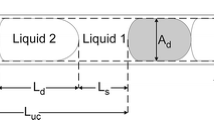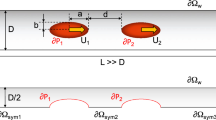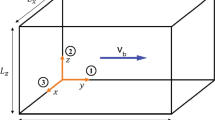Abstract
The dynamics of discrete slugs made of perfectly or partially wetting liquids is studied experimentally in microchannels with rectangular cross-sections. Two contributions to the applied pressure drop govern the observed steady motions during which the length and the speed of a slug remain constant. The first contribution is the viscous dissipation in the liquid column between the menisci of the slug and is approximated by the Hagen–Poiseuille’s law. The second contribution arises at the vicinity of the menisci and is deduced from the experimental data. Distinct regimes are observed for this contribution depending on the wetting properties of the liquid and on the capillary number Ca. In the dynamic regime, a typical visco-capillary scaling in Ca 2/3 is found for the wetting liquid whereas the contribution of the menisci in partial wetting tends towards the previous scaling as the capillary number increases. A quasi-static regime is observed in partial wetting at low driving pressures and the capillary number increases exponentially. This observation suggests the influence of friction on the motion of the contact line and leads us to discuss its effects in the dynamic regime. In particular, experimental results are compared to an empirical prediction involving the previous mechanism as well as dynamic contact angles.











Similar content being viewed by others
Explore related subjects
Discover the latest articles and news from researchers in related subjects, suggested using machine learning.References
Adzima BJ, Velankar SS (2006) Pressure drops for droplet flows in microfluidic channels. J Micromech Microeng 16(8):1504–1510
Ajaev V, Homsy G (2006) Modeling shapes and dynamics of confined bubbles. Annu Rev Fluid Mech 38(1):277–307
Bico J, Quéré D (2001) Falling slugs. J Colloid Interface Sci 243:262–264
Bico J, Quéré D (2002) Rise of liquids and bubbles in angular capillary tubes. J Colloid Interface Sci 247:162–166
Blake TD (2006) The physics of moving wetting lines. J Colloid Interface Sci 299(1):1–13
Blake TD, Shikhmurzaev Y (2002) Dynamic wetting by liquids of different viscosity. J Colloid Interface Sci 253(1):196–202
Bowden N, Andreas T, Carbeck J, Whitesides G (1997) Self-assembly of mesoscale objects into ordered two-dimensional arrays. Science 276:233–235
Bretherton F (1961) The motion of long bubbles in tubes. J Fluid Mech 10:166–188
Brody J, Yager P, Goldstein R, Austin R (1996) Biotechnology at low Reynolds numbers. Biophys J 71:3430–3441
Caço A, Dias A, Marrucho IM, Piñeiro M, Santos L, Coutinho J (2003) Thermophysical properties of perfluorocompounds. In: 15th symposium on thermophysical properties, Boulder, CO, USA
Concus P, Finn R (1974) On the capillary free surfaces in the absence of gravity. Acta Math 132:177–198
Cox R (1986) The dynamics of spreading of liquids on a solid surface. J Fluid Mech 168:169–220
Cubaud T, Ho CM (2004) Transport of bubbles in square microchannels. Phys Fluids 16(12):4575–4585
Cubaud T, Ulmanella U, Ho CM (2004) Multiphase flow in microchannels with surface modifications. In: 5th international conference on multiphase flow, Yokohama, Japan
de Gennes P (1985) Wetting: statics and dynamics. Rev Mod Phys 57(3):827–863
Dong M, Chatzis I (1995) The imbibition and flow of a wetting liquid along the corners of a square capillary tube. J Colloid Interface Sci 172:278–288
Dreyfus R, Tabeling P, Willaime H (2003) Ordered and disordered patterns in two-phase flows in microchannels. Phys Rev Lett 90(14):144505/1–4
Dussan EB (1979) On the spreading of liquids on solid surfaces: static and dynamic contact lines. Annu Rev Fluid Mech 11(1):371–400
Eggers J (2005) Contact line motion for partially wetting fluids. Phys Rev E 72:061605
Fermigier M, Jenfer P (1991) An experimental investigation of the dynamic contact angle in liquid-liquid systems. J Colloid Interface Sci 146(1):226–241
Finn R (1986) Equilibrium capillary surfaces. Springer-Velag, New York
Finn R (1999) Capillary surface interfaces. Notices AMS 46(7):770–781
Freire M, Ferreira A, Fonseca I, Marrucho I, Coutinho J (2008) Viscosities of liquid fluorocompounds. J Chem Eng Data 53(2):538–542
Fuerstman MJ, Lai A, Thurlow ME, Shevkoplyas SS, Stone HA, Whitesides GM (2007) The pressure drop along rectangular microchannels containing bubbles. Lab Chip 7:1479–1489
Garstecki P, Gitlin I, DiLuzio W, Whitesides G, Kumacheva E, Stone HA (2004) Formation of monodisperse bubbles in a microfluidic flow-focusing device. Appl Phys Lett 85(13):2649–2651
Günther A, Jensen K (2006) Multiphase microfluidics: from flow characteristics to chemical and materials synthesis. Lab Chip 6:1487–1503
Günther A, Jhunjhunwala M, Thalmann M, Schmidt M, Jensen K (2005) Micromixing of miscible liquids in segmented gas-liquid flow. Langmuir 21(4):1547–55
Handique K, Burke D, Mastrangelo C, Burns M (2001) On-chip thermopneumatic pressure for discrete drop pumping. Anal Chem 73(8):1831–1838
Hazel A, Heil M (2002) The steady propagation of a semi-infinite bubble onto a tube of elliptical or rectangular cross-section. J Fluid Mech 470:91–114
He B, Patankar N, Lee J (2003) Multiple equilibrium droplet shapes and design criterion for rough hydrophobic surfaces. Langmuir 19:4999–5003
He M, Szuchmacher Blum A, Overney G, Overney RM (2002) Effect of interfacial liquid structuring on the coherence length in nanolubrication. Phys Rev Lett 88(15):154–302
Ichikawa N, Hosokawa K, Maeda R (2004) Interface motion of capillary-driven flow in rectangular microchannel. J Colloid Interface Sci 280:155–164
Joanny J, Robbins M (1990) Motion of a contact line on a heterogeneous surface. J Chem Phys 92(5):3206–3212
Jousse F, Lian G, Janes R, Melrose J (2005) Compact model for multi-phase liquid-liquid flows in micro-fluidic devices. Lab Chip 5:646–656
Kawahara A, Chung PY, Kawaji M (2002) Investigation of two-phase flow pattern, void fraction and pressure drop in a microchannel. Int J Mult Flow 28(9):1411–1435
Lee C, Homma H, Izumi K (2002) Surface properties of polydimethylsiloxane/poly(trifluoropropylmethylvinylsiloxane) blend for outdoor insulator. Trans Inst El Eng Jap 122-A(1):112–117
Lee J, Park C, Whitesides G (2003) Solvent compatibility of poly(dimethylsiloxane)-based microfluidic devices. Anal Chem 75:6544–54
Lenormand R, Zarcone C, Sarr A (1983) Mechanisms of the displacement of one fluid by another in a network of capillary ducts. J Fluid Mech 135:337–353
Li W, Nie Z, Zhang H, Paquet C, Seo M, Garstecki P, Kumacheva E (2007) Screening of the effect of surface energy of microchannels on microfluidic emulsification. Langmuir 23:8010–8014
Marsh J, Garoff S, Dussan V E (1993) Dynamic contact angles and hydrodynamics near a moving contact line. Phys Rev Lett 70(18):2778–2781
Morra M, Occhiello E, Marola R, Garbasi F, Humphrey P, Johnson D (1990) On the aging of oxygen plasma-treated polydimethylsiloxane. J Colloid Interface Sci 137(1):11–24
Mumley TE, Radke CJ, Williams MC (1986) Kinetics of liquid/liquid capillary rise. I—experimental observations. J Colloid Interface Sci 109(2):413–425
Ody C, Baroud C, de Langre E (2007) Transport of wetting liquid plugs in bifurcating microfluidic channels. J Colloid Interface Sci 308(1):231–238
Quake S, Scherer A (2000) From micro- to nano-fabrication with soft materials. Science 290(5496):1536–1540
Quéré D (1991) Sur la vitesse minimale d’étalement en mouillage partiel. CR Acad Sc Paris, Série II 313:313–318
Raphael E, de Gennes P (1989) Dynamics of wetting with nonideal surfaces. The single defect problem. J Chem Phys 90(12):7577–7584
Ratulowski J, Chang HC (1989) Transport of gas bubbles in capillaries. Phys Fluids A 1(10):1642–1655
Song H, Tice J, Ismagilov R (2003) A microfluidic system for controlling reaction networks in time. Angew Chem Int Ed 42(7):768–772
Squires T, Quake S (2005) Microfluidics: fluid physics at the nanoliter scale. Rev Mod Phys 77:977–1026
Stark J, Manga M (2000) The motion of long bubbles in a network of tubes. Transp Porous Media 40:201–218
Stokes J, Higgins M, Kushnick A, Bhattacharya S (1990) Harmonic generation as a probe of dissipation at a moving contact line. Phys Rev Lett 65(15):1885–1888
Stone H, Stroock A, Ajdari A (2004) Engineering flows in small devices: microfluidics toward a lab-on-a-chip. Annu Rev Fluid Mech 36:381–411
Thulasidas T, Abraham M, Cerro R (1995) Bubble-train flow in capillaries of circular and square cross section. Chem Eng Sci 50(2):183–199
van Steijn V, Kreutzer MT, Kleijn CR (2008) Velocity fluctuations of segmented flow in microchannels. Chem Eng J 135(1):159–165
Wong H, Radke C, Morris S (1995) The motion of long bubbles in polygonal capillaries. Part II. Drag, fluid pressure and fluid flow. J Fluid Mech 292:95–110
Xia Y, Whitesides G (1998) Soft lithography. Angew Chem Int Ed 37(5):550–575
Zheng Y, Anderson J, Suresh V, Grotberg J (2005) Effect of gravity on liquid plug transport through an airway bifurcation model. J Biomech Eng 127:798–806
Zhou MY, Sheng P (1990) Dynamics of immiscible-fluid displacement in a capillary tube. Phys Rev Lett 64(8):882–885
Acknowledgements
I am grateful to José Bico who suggested the method of calculation of the capillary contributions and to Pascal Hémon for his help with the second camera. I also would like to thank Charles Baroud, Emmanuel de Langre, Matthias Heil and Élise Lorenceau.
Author information
Authors and Affiliations
Corresponding author
Rights and permissions
About this article
Cite this article
Ody, C.P. Capillary contributions to the dynamics of discrete slugs in microchannels. Microfluid Nanofluid 9, 397–410 (2010). https://doi.org/10.1007/s10404-009-0557-8
Received:
Accepted:
Published:
Issue Date:
DOI: https://doi.org/10.1007/s10404-009-0557-8




